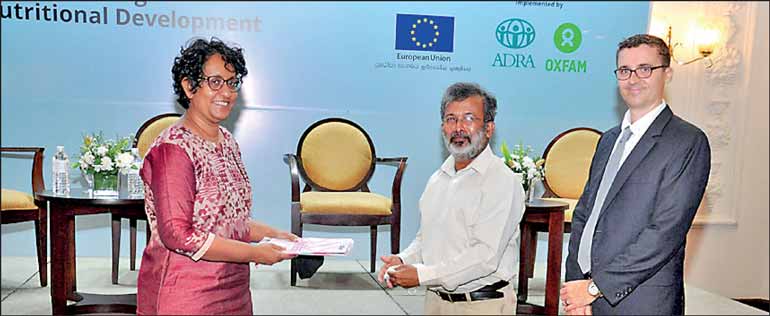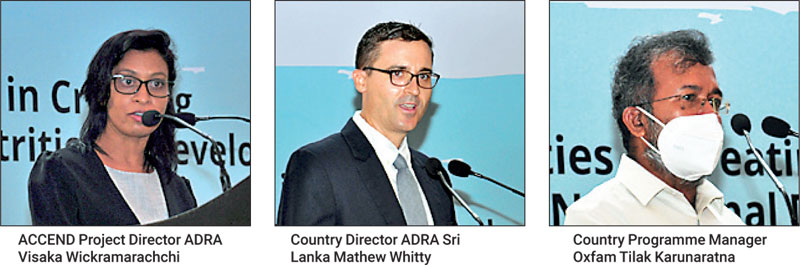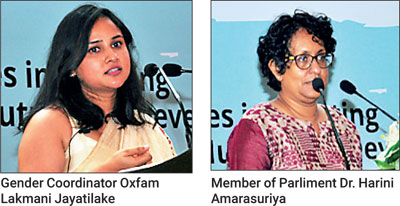Saturday Jan 03, 2026
Saturday Jan 03, 2026
Wednesday, 23 March 2022 00:00 - - {{hitsCtrl.values.hits}}


From left: Moderator Sathya Karunaratne, Dr. Rashmira Balasuriya, Vraie Balthazaar and Lakmani Jayatilake
By Shailendree Wickrama Adittiya

 In a country with a female population of 11.2 million, which is 51.6% of the total population, a 52% tax is charged on menstrual hygiene products. This tax, often referred to as a period tax or a menstrual tax, makes essential sanitary products inaccessible, especially to persons from low income earning households.
In a country with a female population of 11.2 million, which is 51.6% of the total population, a 52% tax is charged on menstrual hygiene products. This tax, often referred to as a period tax or a menstrual tax, makes essential sanitary products inaccessible, especially to persons from low income earning households.
Research conducted by Advocata Institute found that Sri Lanka’s period poverty rate is 50%. This means that 50% of households with women of menstruating age do not report spending any amount of money on sanitary napkins.
Period poverty is a term used when women and girls cannot afford menstrual hygiene products. The exorbitant tax on sanitary napkins and tampons adds to the retail price, making them unaffordable. The 52% menstrual tax in the country is made up of 15% general duty, 15% CESS tax, 10% PAL and 8% VAT.
Taking a closer look at the tax on menstrual hygiene products and the impact of resulting high retail prices on women and girls is explored in the recently launched policy analysis, Taxing menstrual hygiene products in Sri Lanka. The study is an initiative of the Assisting Communities in Creating Environmental and Nutritional Development (ACCEND) Project. The study was conducted by Advocata Institute.
Sri Lanka’s cultural norms tend to make menstruation a taboo topic, resulting in a lack of education and awareness about menstruation as well as reproductive health and sanitary products. When looking at the latter, accessibility and affordability are main issues women and girls face in the country.
Period poverty in Sri Lanka
What does it really mean that 50% of households with women of menstruating age do not spend on menstrual hygiene products? Sharing the findings of the study, Oxfam Gender Coordinator Lakmini Jayathilake said there is a belief in society that women in Sri Lanka have always managed when it comes to sanitary products. However, Jayathilake argues that, in reality, this is still very much a problem that affects 52% of the population.
“We understood, through our research, that period poverty comes in three layers. The first layer being the lack of education and awareness in relation to basic sexual reproductive health. This includes menstruation,” she said, adding that a lack of infrastructure that supports active participation of women and girls in the workplace and school as well as lack of access to cost-effective menstrual hygiene products overall in the country are other key issues.
A study conducted in 2019 in the estate sector to learn more about education about menstrual hygiene found that only 20% of girls learnt about menstruation in schools, while 68.8% of girls learnt about it from their mothers. The problem here is that the study also found that the level of awareness among the mothers was very low and was influenced by cultural norms and myths.
“We found out that 53.7% of girls actually only found out about menstruation once they got it for the first time. And then we asked them, what did you feel when you got menstruation for the first time and 78.4% said that the first thing they felt was fear,” Jayathilake said, emphasising the importance of education on sexual reproductive health.
The second layer of period poverty is the lack of infrastructure and support in the workplace and school. This includes a lack of toilets, disposal facilities, hand washing units and secure bathing places.
“Sri Lanka, for the past two decades and counting, still has less than 35% of women in the formal economy. One of the reasons for this is the fact that we do not create a conducive environment for women, especially to come into the formal sector,” Jayathilake added.
Looking at period poverty from a broader perspective, keynote speaker at the launch of the study National People’s Power (NPP) Parliamentarian Dr. Harini Amarasuriya said, “What this issue shows us is the lack of priority that is given to women’s health and women’s issues in this country. It is not just about the lack of access to sanitary products.”
She explained that there are still schools in the country that do not have proper water and sanitation or disposal facilities.
“None of the schools that we went to actually have a way that the girls can safely dispose of sanitary napkins or change pads during school time. Many of the girls we spoke to and the teachers we spoke to talked about how they, and I think many of us have done the same thing, simply carry these things home, if they can afford to change their pad at all,” Dr. Amarasuriya said.
She stressed that it is completely unacceptable in this day and age that women have to still struggle to have these basic needs met.
“Most of us who travel long-distance know about the problem of adequate toilet facilities along the main roads,” Dr. Amarasuriya went on to say. This is in stark contrast to the fully-carpeted roads and wonderful highways the country boasts of.
What does the 52% tax mean to girls and women?
Focusing on the tax on sanitary products, as Dr. Amarasuriya said in her keynote speech, there is no arguing that the 52% tax on menstrual hygiene products must be removed. There are many reasons for this.
According to feminist researcher and activist Vraie Cally Balthazaar, the high cost of sanitary products takes a toll on families and causes friction within the home front. She explained that a daily wage earner makes Rs. 900 a day, with which they must provide for their family. If they have a wife and at least one daughter, the cost of menstrual hygiene products needed monthly adds up.
The cost of sanitary products makes them see a period as a burden to their family, which is really scary, she said, adding, “I know in certain instances where it causes friction between husband and wife because it is about the economics of your home.”
“The biggest, grimmest understanding for us has been how much of this we carry in our lived experiences as women, be it in urban or rural Sri Lanka. And I know it is true for many South Asian homes, but in particular, we do not understand our own bodies. That is where we have to start,” Balthazaar went on to say.
The high cost of menstrual hygiene products can also limit women in terms of participation in the formal economy.
“Absenteeism has become the norm to fall to,” Jayathilake said, adding that girls tend to refrain from attending school due to the cost of sanitary napkins, lack of infrastructure, and pain related to menstruation.
Lobbying for the removal of the 52% tax thus also draws focus to other interconnected issues.
This is a problem that needs to be addressed holistically, Dr. Amarasuriya said, adding that we pick and choose what we want to highlight and work on but issues are more complicated and interlinked.
She explained that our economic policy, health policy, gender policy, and education policy are all linked. “So unless we have a holistic view about how overall national policy-making and how overall national prioritising affects these issues, I think, we sometimes get lost in the details or we campaign on details without necessarily seeing how one issue links to the other,” Dr. Amarasuriya said.
She explained that unless we have economic policies that understand the importance of women’s labour and work and how women’s labour needs to be reorganised in terms of the unpaid care work that they do, our economy will always be conceptualised leaving out a whole area of work and life that is absolutely essential to us.
This overlooks the need for services, like proper healthcare systems, education, day-care facilities and transport, that will make women’s unpaid care work a little less complicated.
“How do we prioritise our economic targets and economic goals in terms of a fairer, kinder, more reasonable world in which the different needs of different members of society are given at least a fairer hearing?” Dr. Amarasuriya questioned.
Echoing these views, Lakmini Jayathilake said issues like the high tax on menstrual hygiene products has a lot to do with the overall gender budgeting we lack, adding that this is not an issue with one specific government but the country as a whole.
“Issues related to women always tend to be given a backseat, so there is never a right time to talk about issues related to menstruation,” Jayathilake said.
Proper use of sanitary products
A point that tends to get raised when talking about the high cost of menstrual hygiene products like pads is the use of alternatives. According to Jayathilake, a study was conducted in 2019 to understand the types of menstrual hygiene products used by women.
“Our findings showed that 70% of women and girls used sanitary napkins throughout their menstruation, 18% switched between the two and 12% only used cloth throughout their menstrual cycle,” she said.
The reasons for the high use of sanitary napkins include fear of leakage, especially for school girls, convenience and aggressive marketing. However, the problem is not the fact that women use sanitary napkins.
Jayathilake explained that due to the high cost of sanitary napkins, girls and women tend to wear the same napkin for a prolonged period of time, predisposing them to other health-related issues and bacterial and fungal infections.
According to Arka Initiative Head of Mentors Dr. Rashmira Balasuriya, menstrual hygiene products, whether they are pads or cloth rags, must be changed every four to six hours, depending on the flow of one’s period. However, with limited access to menstrual hygiene products, people stretch the use of a pad or cloth rag to 12 or even 16 hours. This makes the sanitary product a breeding ground for bacteria or fungal infections and can lead to cervical cancer later on in life as well as other complications.
The use of cloth rags is an alternative to sanitary napkins that many choose when they have limited access to menstrual hygiene products. However, when using cloth rags, there is a proper way of washing, drying and storing them to make sure they are hygienic.
Not cleaning, drying or storing cloth rags properly can lead to urinary tract infections, fungal infections, etc., Dr. Balasuriya said.
How will the repeal of taxes help?
There are thus several issues connected to the high tax on menstrual hygiene products. According to the study, removing the menstrual tax ensures the welfare of menstruating persons by improving affordability and agency.
This is done through the free flow of imported products in the local market as well as reduced retail prices and cheaper products. Women and girls will thus have more choices.
“Imported products will encourage the local producer to stay price competitive and to improve the quality of local menstrual hygiene products benefiting the consumer and consumer welfare at large,” the synopsis states, adding that flow of a variety of products into the market will open up the possibility of tapping into new markets. This includes menstrual cups and sustainable sanitary napkins.
Removal of the tax also improves overall comfort, emotional wellbeing and school experience of girls and comfort and emotional wellbeing of menstruating persons in the workplace. It also decreases health risks like vulnerability to cervical cancer and urogenital infections.
The removal of the tax especially benefits low income earning women and girls, making menstrual hygiene products more affordable and accessible. It will also benefit local producers and encourage cheaper products to enter the market, since protective border taxes eliminate all incentives for local producers to improve the quality of their products and stay price competitive.
The study by ACCEND argues that the high tax not only makes essential menstrual hygiene products unaffordable but that only Rs. 120 million or 0.005% of the total tax revenue was from the tax on sanitary products in 2019.
“In short, protective border taxes on menstrual hygiene products protect and benefit a smaller segment of society at the expense of the welfare of low-income earning menstruating women. In economics, this is titled rent seeking behaviour,” the synopsis goes on to say.
Policy and implementation
The study on taxing menstrual hygiene products in Sri Lanka is one that sheds light on an important issue that affects a large portion of the population. The study is an initiative of the ACCEND Project and is funded by the European Union and implemented jointly by ADRA UK, ADRA Sri Lanka and Oxfam.
The project covers 52 communities in the Nuwara Eliya, Matale and Monaragala Districts and targets both rural and estate populations. The beneficiaries of ACCEND are women and children from poor and vulnerable families in these areas, Oxfam Country Program Manager Tilak Karunaratne said.
The project is a grant of 5.8 million euros and is a project for 57 months. Highlighting challenges like continuity and sustainability, Head of Cooperation of the Delegation of the European Union to Sri Lanka and the Maldives Jenny Correia Nunes said, “It is great that we have projects like we have now with ADRA and Oxfam but what do we do when that projects finish? And that is why we need to look much more at the policy level.”
The recommendations made based on the findings of the study are crucial for this reason.
“The Government can do without this discriminatory tax as it is a negligible proportion of the island’s total tax revenue,” the synopsis of the policy analysis on the 52% menstrual tax states. The study thus recommends that the general duty, CESS, PAL and VAT components are removed from sanitary products.
The study also recommends removing tariffs on imported raw material used to produce sanitary napkins and other menstrual hygiene products. The Finance Ministry should declare the reduction in taxes through the means of an Extraordinary Gazette, the study adds.
Dr. Harini Amarasuriya however pointed out that implementation of policy recommendations is key.
“Something that I have learnt over the last couple of years is that you can develop as good a policy as you want or you can do as excellent a piece of research as you want, but unless there is money allocated for actually implementing the recommendations of your study or the recommendations that come out of policies, there is absolutely no use,” Dr. Amarasuriya said.
She went on to say that there are excellent policies and good research done on these issues. “What I have found is that the block is always when it comes to implementation,” she added.
“Successive governments have consistently allocated very little for these kinds of issues, which means that then the State services are really handicapped when it comes to responding to these kinds of needs,” Dr. Amarasuriya went on to say, adding that proper analysis of our budgets and how money is allocated is needed. “This issue is also to do with, unfortunately, rupees and cents,” she said, explaining that it has to do with the allocation of money not only for research but also for services that go towards supporting women.
“If you look at our annual budget, you will very quickly get an idea about how much successive governments have prioritised women and women’s issues, let alone women’s health. There are so many services that are lacking in our country,” Dr. Amarasuriya went on to say.
Pix by Sameera Wijesinghe

